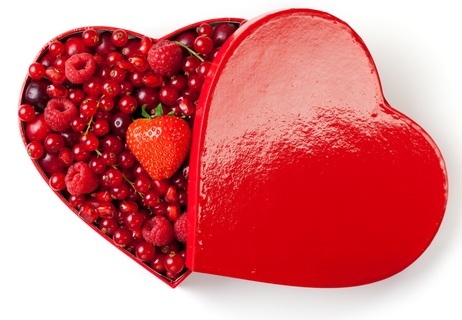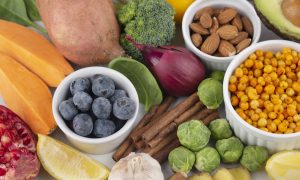By Emily C. Harrison MS, RD, LD
www.dancernutrition.com
Dance Informa is celebrating heart health this Valentine’s Day by highlighting five red foods that are good for the one muscle in your body that never gets a rest. These foods are also great for recovering from a tough rehearsal, for keeping a healthy body weight and for preventing cancer and heart disease – but most importantly, they taste good!
In the United States, heart disease is the leading cause of death for both men and women1. One out of every four deaths is from heart disease in the US1. Being physically active, maintaining a healthy body weight, and eating more colorful fruits and veggies can reduce your risk.
Strawberries
At only 43 calories per cup, berries contain vitamin C, folate and potassium, in addition to cancer-fighting flavonoids, such as anthocyanins. Flavonoids are antioxidants that combat oxidative stress on the body and protect against free radicals that cause cell damage. This is good news for dancers who push their bodies to the extreme and is especially helpful in urban areas where city pollution can be a source of oxidative stress. The Nurse’s Health Study II reported that people who ate berries more frequently (more than once a month) were 32 percent less likely to have a heart attack than people who ate berries infrequently. Berries also protect the heart with their anti-inflammatory properties. Be sure to choose organic berries as often as possible. The Environmental Working Group (EWG) lists these on their “Dirty Dozen” list of fruits and vegetables that are typically high in pesticides2.
Peppers
Sweet or hot, raw or cooked, there is no doubt that these are super healthy foods. Sweet red peppers contain vitamins C and A, but they are also a good source of vitamin B6, which aids in protein metabolism. Because red peppers have been left on the plant to mature longer than green ones, they are better sources of antioxidants. They are great sliced and dipped in hummus or chopped in a chili or stew. These are also on EWG’s Dirty Dozen list so it’s worth the money to buy organic.
Tomatoes
These are a great source of vitamins C and K. They also contain vitamin A and the carotenoids lutein, and lycopene. These are antioxidants, powerful cancer fighters and are very heart protective. Research has shown that cooked tomatoes, like in sauces and stews, can have additional benefits. So enjoy them raw and cooked. Eat the skins as well, as the skins contain many health-promoting phytonutrients. This is another food on EWG’s Dirty Dozen list, so once again we recommend that you buy organic. Try tomatoes in a winter chili with the next heart healthy food on our list – red beans.
Red Beans
A fantastic source of plant based protein and fiber, red or ‘kidney’ beans also contain folate, iron, manganese, copper, potassium and several other minerals. Current recommendations from a variety of health organizations tell us to get protein from more plant-based sources in general. Beans are a cheap source of organic protein, which with the fiber will help you feel fuller longer and can keep blood sugar more stable. I would strongly recommend avoiding canned beans because canned products are lined with a plastic coating that contains BPA, which is a known neuroendocrine disruptor. It’s so easy to throw some beans in a slow cooker in the morning and they are ready when you get home. During cooking, don’t add salt or something acidic like tomatoes. Wait until the beans are softened to add these. If you soak beans overnight and then give them a good rinse before cooking or eating you can reduce the substance that gives them their reputation for being gas-producing.
Beets
These bright red root veggies are hot in the sports nutrition field right now because they are a great source of naturally occurring nitrates. Naturally occurring nitrates in foods like beets, arugula, spinach and rhubarb have been shown to significantly improve athletic performance with better power output, more endurance and speed. Dancers might see benefits by eating more of these veggies or drinking beetroot juice. Nitrate supplementation from pills has not shown the same benefits as consuming the actual vegetable. It’s important to note that cured or processed meats contain nitrates too, but interestingly these have a completely different effect on the body and cause cell damage instead. Cook beets in water until soft and then add them to salads.
There are plenty of other great red foods out there so don’t forget to also include these in your daily food choices – cherries, watermelon, red cabbage, raspberries, cranberries, ruby red grapefruit, pomegranate, apples and many others. Enjoy!
Emily Harrison
 Emily Cook Harrison MS, RD, LD
Emily Cook Harrison MS, RD, LD
Emily is a registered dietitian and holds both a bachelor’s and master’s degree in nutrition from Georgia State University. Her master’s thesis research was on elite level ballet dancers and nutrition and she has experience providing nutrition services for weight management, sports nutrition, disordered eating, disease prevention, and food allergies. Emily was a professional dancer for eleven years with the Atlanta Ballet and several other companies. She is a dance educator and the mother of two young children. She now runs the Centre for Dance Nutrition and Healthy Lifestyles. She can be reached at emily@dancernutrition.com www.dancernutrition.com
Sources:
1. Centers for Disease Control: www.CDC.gov
2. Environmental Working Group: www.ewg.org
Photo: © Svetlana Kolpakova | Dreamstime.com















